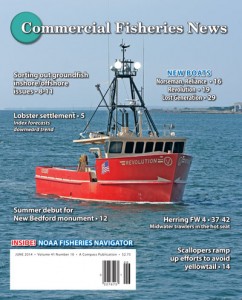WALPOLE, ME – Recent references at public meetings to marked declines in the settlement of young-of-the-year and juvenile lobsters all along the Maine coast (see CFN April 2014) were confirmed with the release of the 2013 American Lobster Settlement Index (ALSI) in early May.
“The diver-based suction sampling survey, our longest ALSI time series, reveals the precipitous downturn in settlement in the Gulf of Maine from southwest Nova Scotia to Massachusetts,” the report stated.
This “widespread and deepening downturn over much of the species’ range is heightening concerns for the future of the region’s lobster fishery,” the report continued.
Now in its 24th year, the ALSI has a proven track record for predicting the abundance of lobsters available to harvesters down the road because the tiny lobsters collected by researchers typically recruit into the fishery anywhere from five to nine years later, depending on water temperatures and other factors affecting individual animals.
“We don’t have a crystal ball. Our forecasting models are still in their infancy,” said Rick Wahle of the University of Maine’s Darling Marine Center, who co-authored the report.
“Nonetheless, the benefit of the settlement index is that it could give us an early warning that we haven’t had in the past and may give the industry and managers time to consider their options should there be an impending drop in landings,” he said.
Further to the south, the news was ever so slightly better. While settlement south of Cape Cod remained barely detectable, small upticks were reported at sampled sites in Massachusetts’ Buzzards Bay and, for the second year in a row, in Rhode Island.
Coordinated by the University of Maine, the ALSI is the product of sampling work by fishermen’s groups and fisheries agencies from Canada to Rhode Island, including: the Maine Department of Marine Resources, the Massachusetts Division of Marine Fisheries, the Rhode Island Division of Fish and Wildlife, Fisheries and Oceans Canada, the University of New Brunswick, the Guysborough County Inshore Fishermen’s Association of Nova Scotia, and the Fishermen and Scientists Research Society of Canada.
 Read the rest and much, much more in the June issue of Commercial Fisheries News.
Read the rest and much, much more in the June issue of Commercial Fisheries News.
Read online immediately and download for future reference.








 Updating...
Updating...